Anyone making a living on the water fly-fishing will tell you they tie flies out of
necessity. It's true. Purchasing flies in the large quantities used by guides
would be very expensive. In the process of tying, I think it is only natural to
modify designs that, even though they work well, get over used. Plus it gets
boring tying the same flies over and over again. The objective in changing a
known design is to make the fly just a little better for the conditions that you fish.
A lot of tweaking can sometimes alter the appearance of a fly; hence a new fly is
born. Sometimes we make minor alterations by adding some tan marabou or find
ways to eliminate dumbell eyes and still have the fly sink. Dumbell eyes tend to
hang up in the grass. Their purpose is to get the fly down on the bottom and come
to rest inverted (hook up).
It isn't simple just making a new design. It must be tested. So multiple copies are
made so that friends and fellow guides can try them. The fly must be durable and
hold up in many situations. They are tested for casting characteristics, sink rate,
activity in the water and most important will they catch fish. Here are three such
modifications which I have tied, tested and guarantee will work under the conditions
discussed.
Redfish Diver
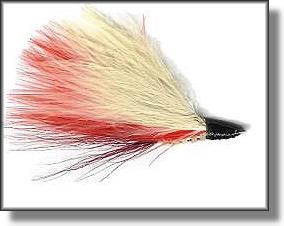
This fly looks similar to a deceiver and has some of the same characteristics of Liz
Steele's Purple Passion (one of my favorite flies). The Redfish Diver has a fast sink
rate, the same as if it were tied with a 1/50 oz dumbell. Here are the details.
Materials
- Hook: Mustad #34007 (#1).
- Thread: Orvis G Smoke monocore thread (02RR-6207).
- Head: No. 25 Lead Wire.
- Tail: Red Buck Tail (1 ½ inches), Orange and Tan marabou
(2 x the hook length) Tie in six strands of gold Krystal flash.
- Body: Tan Ultra Chenille.
Method
1. Tie off a small section of thread, then place a 1-inch piece of No. 25 lead wire folded
and crimped and tied 1/8 inch behind the eye. Tie to the back of the lead wire; wrap once
behind and over to secure the lead wire (you can also super glue the wire to the shank).
2. Run the thread to the curve of the shank and tie in the red buck tail (about ½ a pencil
thickness). Tie six strands of gold Krystal flash and then the tan ultra chenille (cut about 7
inches of chenille). Wind the mono thread to the front just behind the eye.
3. Wrap the chenille forward tightly and bring to just behind the eye. Tie a uni-knot over
the eye with the chenille.
4. Braid the Krystal flash by twisting or twirling the strands together and wrap them over
the chenille leaving about 1/32 inch between as you spiral the wraps forward and tie off
behind the eye.
5. Turn the hook over so that the shank is down and the hook is on the topside.
6. About ¼ inch behind the eye, tie in a small clump of orange marabou, then tan marabou.
The marabou should just cover the hook point, making the fly weedless.
7. Now tie off and whip finish the fly.
This fly is very effective in clear water or in cloudy water (not murky). The fly sinks fast
and will be in on the bottom in about 6 seconds (18 inches deep). The retrieve is a slow
constant retrieve. Only strip about 3 inches at a time. Because the weight is forward and
there are no dumbbells the fly will not hang up in the grass. Redfish really like this fly. I've
lost a number because they inhale it into their throat crushers, if this happens just cut the line.
The hook will dissolve in about 4 hours.
Redfish Bugger
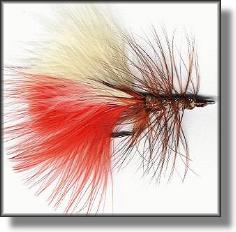
This fly is similar to a fly pattern designed by Dana Griffin of Gainesville, Florida, except
without dumbell eyes. This fly uses lead wire as a head weight
Materials
- Hook: : Mustad #34011 (1/0).
- Head: : #25 Lead Wire Wrapped to Bend.
- Thread: : Rust colored 6/0 mono thread.
- Tail: : Orange and Tan marabou (2 x the hook length), tie in six
strands of gold Krystal flash.
- Body: : Tan Ultra Chenille with orange dyed grizzly hackle palmered.
Method
1. Tie in #25 lead wire 1/8 inch behind the hook eye.
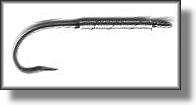
2. Lead wire is wound around the shank leaving about 1/8 inch to the hook eye.
Thread is wrapped forming a collar in front of the wire and behind the wire before
the shank bend.
3. Select marabou feathers of orange and tan and tie in at rear of hook bend, tan
above and orange underneath.
4. On each side of the wing, tie in 6 strands of gold Krystal flash and leave hanging.
5. Tie in a 6-inch segment of tan chenille and at the same point at the rear of the hook tie
in the orange grizzly hackle at angle suitable for palmering. Run your thread up to the hook
eye and leave hanging.
6. Wrap the chenille forward in tight winds to just behind the hook eye and tie off.
7. Take the 6 strands of flash and twist to make a kind of rope and pull straight forward so the
strand runs along the side of the shank and tie behind the eyes. Do the same thing for the
other side of the shank.
8. The final step is palmering the feather, making space between the turns so that the gold
flash will show through.
9. Now tie off and whip finish.
This fly is very effective in grass flats in windy conditions, and in situations where there
is sand (white holes) scattered throughout the flat. This fly will sink fast and a slow
retrieve is recommended.
Tarpon Bugger
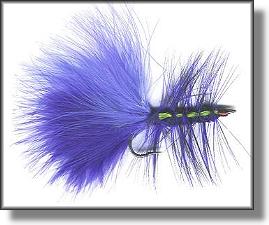
You'll notice that this fly resembles a Woolly Bugger (another of my favorite flies). I tie
it in a number of ways including my Tarpon Bugger.
The Tarpon Bugger is tied in the same manner as a Woolly Bugger, but uses
Purple and Blue marabou, purple chenille, chartreuse super hair and Purple
Grizzly Hackle. The Tarpon Bugger is really effective at night and daytime
in brackish backwaters and creeks. I've had redfish hit this fly at night.
Redfish Assassin
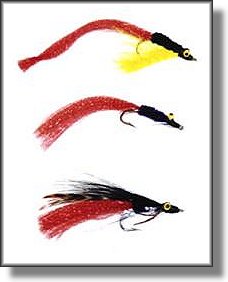
I got the idea for this fly after watching a guide using a Bass Assassin. I didn't have
a trip and was actually about 150 yards away from a guide working a mangrove line.
I was intrigued by his work and watched intently with my binoculars from a distance.
I had used Crazy Charles type jerk worm before but it hadn't occurred to me to try
tying a fly to emulate it. Jerk worms work best in cloudy, murky or dark water, or
on a cloudy day. The action is similar to a shrimp, but more than likely imitates a
sand worm or eel.
I've tried many different renditions of this fly and these three work best. You'll find
a similar fly imitating a needlefish. This fly has been effective with redfish, black drum,
jacks, catfish and snook. I've caught a flounder on a fly made of white super hair.
So there are many ways to tie this – but here is the simplest.
Materials
- Hook: Mustad #34007 (#1).
- Thread: 6/0 mono thread.
- Head: 1/50 oz yellow/black eye dumbell.
- Tail: Orange super hair tail (1½ inches), Black buck
tail 2½ inches long.
- Body: Black Ultra Chenille.
- Guard: 80 # mono or gold Mylar weed guard is optional,
Method
1. Tie in dumbbell eyes behind the hook eye.
2. Select orange super hair and tie in at rear of hook bend.
3. Tie in a 5-inch segment of black chenille and at the same point at the rear of the hook
tie in silver Mylar. Run your thread up to the hook eye and leave hanging.
4. Wrap the chenille forward in tight winds to just behind the hook eye and tie off. Take
the Mylar and pull it straight forward so that the strand runs along the belly of the shank
and tie behind the eyes.
5. The final step is tying black buck tail in over the eyes to just behind the hook eye. Now
tie off and whip finish.
This fly is a killer in dark or brackish water. Reds attack this fly with fury. Most hits are
made on the second or third strip. Strip is slow, pause, and slow. The fly will sink pretty
fast, so you want to keep it off the bottom and just hopping. The strip action will pick it up
and allow it to sink again. After the cast count to five and start the strip. This is a
deadly fly at dusk. I'm sure it would work in freshwater even though I haven't tried it there.
Most flies are modifications of old designs that still work well. Try some of your own.
Make the same ones or modify the ones here. Experiment, have fun and go out and
fool some big fish. ~ Doug
About Doug:
Doug is a fly-fishing guide from New Smyrna Beach, FL. He is a member of CCA,
FFF, AFF, APCA, and FOWA. He can be reached at 386-679-5814.
|






